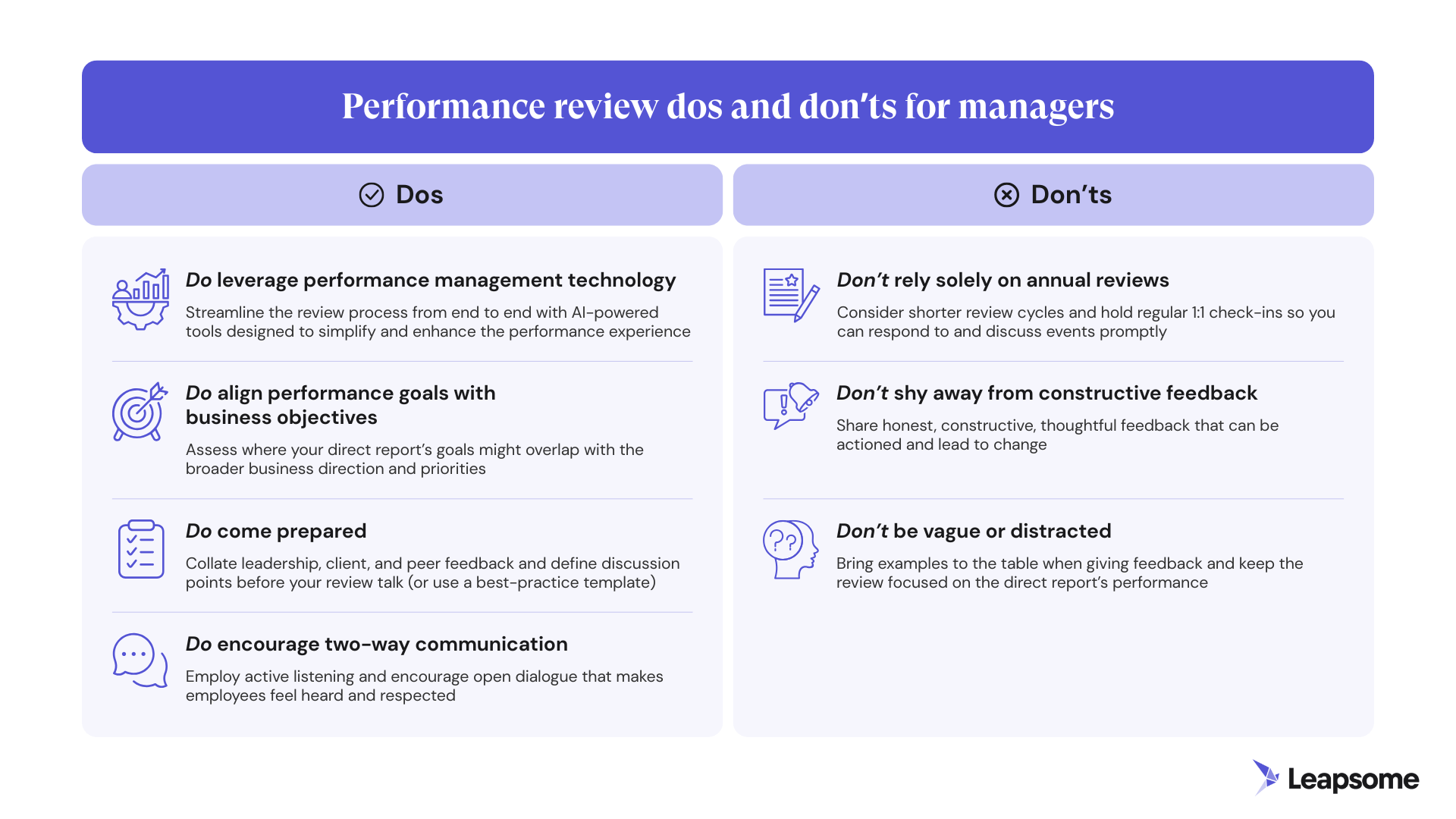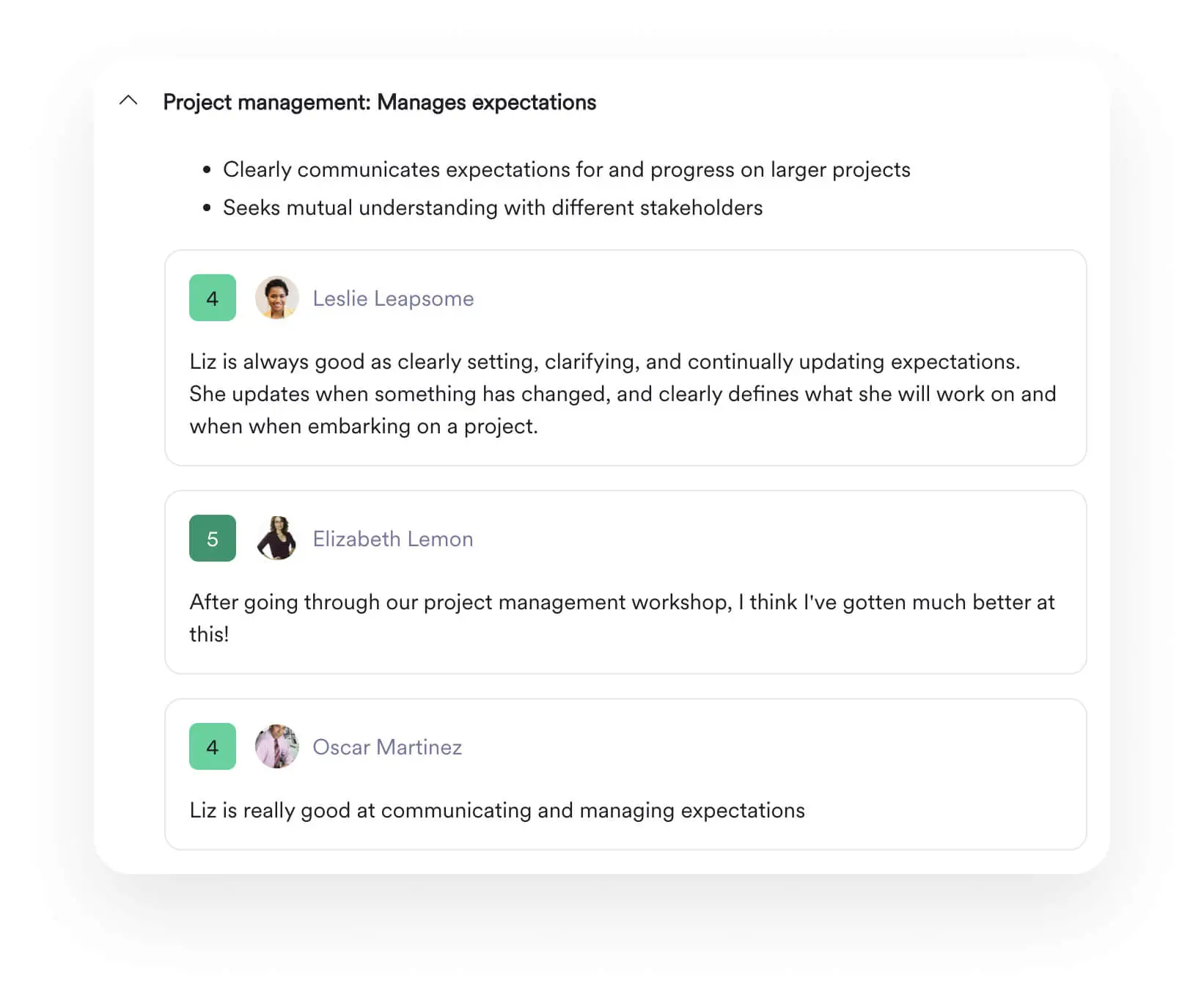Performance reviews: the ultimate guide

Performance management is evolving. Formal performance reviews — or performance appraisals — have been a cornerstone of employee development for decades, but today’s workforce needs more than a once-a-year evaluation. Skill sets are evolving faster, employee expectations are rising, and workplace speed has increased.
Annual reviews alone can’t keep pace with this environment. More frequent, well-structured reviews help meet employees’ evolving needs. When done right, performance reviews help employees and organizations grow in strategic alignment. However, with the wrong structure, questions, or objectives, businesses risk demotivating team members and prioritizing company success over individual development.
Today’s professionals want constructive feedback — 8 of 10 employees say it enhances productivity.* But how can managers ensure performance evaluations balance meaningful feedback, praise, and actionable guidance?
In this guide, we’ll unpack how technology is changing employee performance reviews for the better and offer an insightful list of dos and don’ts for managers and HR professionals.
⚡️ Unlock the power of performance reviews
Take a self-guided tour through our intuitive Reviews module and see how it can transform your performance review process.
👉 Take a product tour
*Leapsome’s Workforce Trends Report, 2024
Why are performance reviews so important for organizations in 2025?
Performance reviews play a vital part in any holistic performance management system. And with up to 39% of US professionals having fully flexible roles, making time for structured discussions can show employees that their growth matters — even without daily face time.
When led by engaged managers, performance reviews can drive motivation and professional development. They demonstrate investment in the employee’s future and help identify growth opportunities. This bolsters satisfaction and retention — and at a time when 34% of professionals want to quit their jobs, the positive impact of performance reviews on individuals and the wider business can’t be understated.
When employee goals align with company objectives, performance reviews also field business growth, helping organizations achieve targets, pursue new initiatives, and innovate.
📚 Explore our library of resources to take your performance reviews to the next level!
⭐️ Read our guide on how to write performance reviews to understand the optimal structure and get guidance on delivering performance feedback.
⭐️ Discover (and download) our performance review templates to help you tailor your employee evaluation approach to individual team members.
⭐️ Browse our list of performance review phrases and learn how to give direct reports constructive, actionable feedback.
⭐️ Check out our performance review tips for expert insights on effectively managing the review process and following up afterward.
⭐️ Explore our guide on performance review questions and determine which queries would be most meaningful and relevant to your direct reports.
⭐️ Take a look at our article on modern performance reviews and read about the five essential elements for success.
⭐️ Read about performance calibrations and their potential to reduce bias.
⭐️ Review our playbook on 360° performance reviews and learn how to improve your feedback culture.
What’s the main purpose of performance reviews?
In an article for the Harvard Business Review, Harvard Senior Lecturer Frank V. Cespedes states that “the purpose of reviews is two-fold: an accurate and actionable evaluation of performance, and then development of that person’s skills in line with job tasks.”
This makes performance evaluations fantastic opportunities to:
- Recognize and praise your direct reports’ efforts and achievements
- Clarify expectations around priorities and responsibilities
- Discuss short- and long-term development opportunities
- Set measurable professional development goals and discuss how to achieve them
- Explore how direct reports’ goals can support broader business objectives
- Foster continuous improvement with constructive feedback
How is AI impacting the performance review process?

Only 22% of employees strongly agree that their performance review process is fair and transparent — highlighting a need for more consistent, unbiased processes. AI tools are transforming performance reviews not only by improving efficiency but also by making them more objective and data-driven.
Once considered unavoidable, bias can now be reduced through tools that analyze concrete data. AI-powered solutions like Leapsome Reviews can collect and process valuable people data, ensuring reviews are based on concrete facts. When used with other resources, like competency frameworks, these tools give managers the balanced views they need to carry out evaluations consistently, fairly, and tailored to each team member’s needs.
Performance reviews: dos & don’ts
Getting performance reviews right doesn’t have to be complicated. Take a look at our list of key dos and don’ts below to learn more.

1. Do leverage performance management technology
Performance management tools are getting more advanced, and finding a solution that suits your business will streamline the process by reducing the admin load and improving time management with features like automated scheduling and reminder notifications.
In addition, an intelligent tool like Leapsome Reviews enables managers to incorporate past performance, feedback from other peers, and goal progress into their assessments, giving them a holistic overview and allowing them to recommend appropriate growth actions.
Our platform also leverages advanced AI to help managers give better feedback, helping them deliver more meaningful reviews.

😌 Streamline & improve your performance reviews
Our Reviews module takes the hassle out of performance evaluations, so you can focus on what matters most.
👉 Explore Leapsome Reviews
2. Do align performance goals with business objectives

Coordinating individual employee goals with organizational objectives is an impactful growth strategy, but it’s crucial to collaboratively set goals direct reports are enthusiastic about.
Through active listening, you should understand how they’d like to progress. Then, you can establish where this might overlap with broader company needs. For instance, if your business has a leadership gap, you might put together a plan to improve their leadership and mentoring skills. Or if they’re passionate about DEIB and your organizational initiatives are lacking, you might encourage them to pursue training in that area.
There are various methodologies for creating an action plan. However, with platforms like Leapsome Goals, you can work with several frameworks, like OKRs and SMART goals, and track progress with goal analytics.
3. Do come prepared
Preparing for your performance evaluation conversation in advance shows direct reports that you’re engaged in the process. So, be sure to plan the discussion points you’ll address — there are many useful example templates available to work from — and consider the language you might use in the discussion.
It’s also helpful to collate notes from previous 1:1 check-ins, relevant goal data, self-assessments, and 360-degree feedback from clients and other team members so you have everything at hand for the meeting.
💡 While you’re at it, are you interested in improving your 1:1 check-ins? We’ve got a detailed template for today’s managers.
4. Do encourage two-way communication
Two-way communication is crucial for an open dialogue between you and your direct reports. It means giving them the time and space to bring things to your attention, raise concerns, ask questions, and share their own constructive feedback.
The simple act of listening can significantly impact employee satisfaction, company culture, and even productivity; not feeling heard can lead to burnout, low commitment, and churn.
5. Don’t rely solely on annual reviews
Less than half of companies rely solely on annual reviews, and many prefer more frequent 1:1 meetings to provide individualized support and guidance.
Having shorter review cycles and organizing regular check-ins gives you and your reports the chance to discuss matters in real time, identifying issues before they become significant and implement changes as early as possible. It also helps ensure that annual performance reviews don’t include any feedback team members are hearing for the first time.
6. Don’t shy away from constructive feedback
Constructive feedback is a fundamental pillar of professional development — yet our 2024 Workforce Trends Report revealed a “feedback gap.” While 71% of managers stated they provided constructive feedback the previous week, only 37% of individual contributors (ICs) reported receiving any.
While honest feedback can feel tricky to deliver, it’s the kindest thing to do. There’s always a way to share areas for improvement thoughtfully; if you feel uncertain about your communication skills in trickier conversations, consider a handful of appropriate performance review phrases in advance.
💡“To build high-performing, highly connected teams, you need managers who set clear goals, build trust, communicate effectively, provide feedback in a remote environment, and lean into difficult conversations.”
— Shelby Wolpa, HR Advisor to Series A-C Startups & Scaleups
7. Don’t be vague or get distracted
One of the biggest mistakes managers make is providing feedback without sharing examples or actionable steps for improvement. This type of feedback is unhelpful and shows a lack of preparation on the manager’s side.
It’s also easy to get sidetracked in meetings with your direct reports. Remember to stay on track and focus on the person’s performance and development.
🚀 Tap into our bank of performance management resources to fine-tune your approach.
👉 Read our guide on performance management systems and choose the right model for your team.
👉 Hear our take on the performance management cycle and discover how it can empower all team members throughout the employee lifecycle.
👉 Browse our round-up of leading performance management software solutions for 2025 and find the best for your organization.
Transform your performance review process with Leapsome
.png)
Performance reviews have the potential to boost employee performance, collaboration, and growth — for your people and your company.
Choosing an AI-powered, purpose-built solution like Leapsome Reviews empowers you to achieve this.
Our platform streamlines the evaluation process, triggering recurring reviews and delivering automated reminders to keep all parties on track. Our reviews tool integrates seamlessly with our HRIS and people enablement modules, like Competency Frameworks, Goals, and Instant Feedback.
By embracing this guidance and adopting an industry-leading tool, you’ll have a performance review process that does your team justice.
👋 Experience Leapsome Reviews for yourself
Ready to give it a try? Book a demo and experience the game-changing features our holistic HR platform can offer your team.
👉 Book a demo
Frequently asked questions about performance reviews
What is a performance review?
A performance review — or a performance evaluation — is a structured assessment that a manager carries out with their direct report to discuss their skills, strengths, and areas for improvement. It’s an opportunity for the manager to provide positive and constructive feedback, share praise from other team members, and set collaborative developmental goals, which can then be reassessed and revisited in the next performance review. These reviews are usually held at regular intervals (e.g., quarterly) and also give employees the chance to advocate for themselves — for instance, if there’s any training they wish to undertake or any specific forms of support they need.
We recommend conducting 360° performance reviews, which incorporate self-assessments and feedback from peers.
Do most companies still hold annual performance reviews?
Although some companies still conduct annual performance reviews, today’s businesses are transitioning to carrying out two (or more) formal evaluations per year, in addition to regular 1:1s between managers and direct reports. These catch-ups may be less formal and follow a looser structure, allowing managers to provide continuous feedback rather than waiting months for the next review.
What’s an example of a good performance review?
A good performance review:
- Evaluates strengths and areas for improvement
- Delivers clear, constructive feedback
- Identifies development opportunities (e.g., training opportunities)
- Sets achievable, measurable goals
- Connects individual development to company objectives
- Recognizes achievements and contributions
- Focuses on both past progress and future growth
Related articles
Back to the blogReady to transform
your People operations?
Automate, connect, and simplify all HR processes across the employee lifecycle.
.webp)
.webp)
 Request a demo today
Request a demo today





.png)























